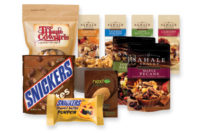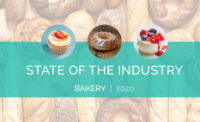Premium’s Out Of The (Illustrious) Bag
By Renee M. Covino
Once driven exclusively by Non-Food/Drug/Mass
channels, premium chocolate has taken flight in the everyday mainstream
circuit.
The ability to trade up one’s chocolate, without having to trade up the store where one shops, is a sweet deal. One that millions of Americans are literally buying into now that premium chocolate is appearing regularly in the mass retail channel.
At first it started out in specialty chains such as
Cost Plus and upscale grocers such as Wegmans and Harris Teeter. Now the
trend has extended to the most mass of mass retailers such as Wal-Mart and
Target, which last October launched its first-ever collection of exclusive
premium-crafted indulgent chocolates. Target’s new Choxie collection
includes such “taste sensations” as Chile Limon Truffle Tiles,
Toffee Almond Crunch and Chai Tea Truffle Temptations. “Gourmet
chocolates have come out of the closet and are showing some muscle in the
mass market arena with exceptional branding that is making gourmet
indulgence a household phenomenon,” notes Don Montuori, spokesperson
for Packaged Facts, a division of MarketResearch.com. “Higher cocoa
content, the health benefits associated with chocolate, and the
introduction of organics, ‘single origin chocolates,’ and
exotic flavors, such as grapefruit and habaneras, are having a major impact
on this industry, helping it grow more quickly than standard
chocolate.”
“Many mass channels and retailers are responsive
to both the premium chocolate and dark chocolate trends,” adds
Fabrizio Parini, senior vice president of marketing for Ghirardelli
Chocolate Company, which has increasingly accommodated mass markets with
its on-the-go Squares and intense dark lines. “Premium chocolate
sales used to be mainly driven by non-FDM channels,” he says.
“As the everyday luxury concept becomes stronger in this category,
the FDM channels will become the main driving force behind premium
chocolate growth.”
Scharffen Berger Chocolate Maker, which creates all of
its chocolate out of bean blends from up to nine different cacao-growing
regions throughout the world, has seen the mass “light,” too,
especially now that it’s part of the Artisan Confections Company, a
wholly owned subsidiary of the Hershey Company.
“They are opening our eyes to a broader market
for the products we make, and that’s a great thing,” says John
Scharffenberger, co-founder of Scharffen Berger. “When we started (in
1996 in San Francisco), we didn’t necessarily want to be an exclusive
chocolate product, just a great chocolate product. We’re still
featured in companies like Whole Foods, which just announced we’re up
another 25 percent in sales, but we’re also starting to find
ourselves at Safeway, H-E-B, Kroger and others that have a more
‘regular’ supermarket clientele.”
It seems consumers from all walks are seeking more
luxury from their consumption choices in order to satisfy their increasing
lifestyle aspirations. “This, together with a trend towards rising
affluence, added time pressures and stress, causes them to trade up to
indulgent, luxury items such as premium chocolates,” according to a
report from independent market analyst Datamonitor.
While the definition of premium chocolate is debatable
(some say it’s chocolate over $8 a pound, some say it expands beyond
just price into more “interesting” flavors, less sugar, and
better packaging), sales of super-premium chocolate are predicted to rise
from $670 million in 2004 to $850 million in 2009, forecasts Datamonitor.
Packaged Facts projects higher — predicting that
the overall “gourmet” chocolate market, which it says also
includes untracked sales through specialty chocolatier boutiques, gourmet
shops, convenience stores, warehouse clubs and other non-chain stores, will
grow 6.4 percent from $1.3 billion in 2005 to $1.8 billion in 2010.
Seasons are particularly important to the premium/mass
chocolate explosion. Seasonal sales tracked through supermarkets,
drugstores, and mass merchandisers (excluding Wal-Mart) accounted for
roughly 29 percent of gourmet sales in 2005, while overall tracked sales
showed 20.2 percent growth over 2004, according to Packaged Facts.
Of particular premium interest is Easter. Premium
Easter chocolate sales increased approximately 31 percent between 2004 and
2006, according to Mintel International, a market research firm in Chicago.
The kid-turned-adult holiday trend is partly responsible.



